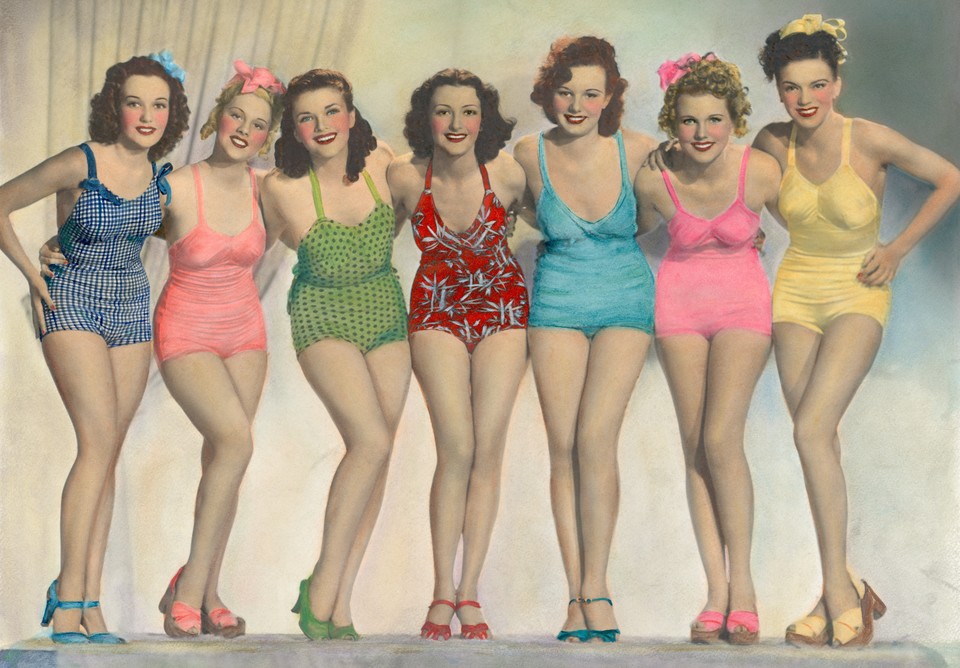The Bathing Suit: A History
As you slip into your bathing suit this summer for a refreshing dip in your Florida pool, think about this: your bikini or even one piece swimsuit is a relatively new invention! While these popular styles popped up in the 20th century, there have been many different styles for as long as people have been swimming.
While information on styles and trends from so early on is hard to collect, the Smithsonian Institution shows us a look at what bathing suits in the 4th century A.D. might have looked like. An Italian mosaic shows women two-piece outfits that look rather similar to the bathing suits of today—minus a few straps and fun polka dot patterns, of course!
Swimming for recreation wasn’t always the universally popular activity it is today. When bathing became popular in the early 1800s, women would wear costumes for the activity that still kept with their modest Victorian standards: long-sleeved dresses made of wool! These outfits would keep women covered up and conservative, as well as very pale (which was the standard of beauty for the time). To prevent any unintentional exposure, the dresses often came with weights in the hems—altogether, a very different look from what we know today.
At the beginning of the 20th century, women wanted swimwear that wasn’t so bulky and heavy. Australian swimmer Annette Kellerman popularized a tighter, slimmer suit with legs, not a skirt—she actually was arrested for wearing it, as it was considered indecent for the times! But soon, more and more women wanted the bathing suit named for its brave pioneer; Annette Kellermans were all the rage. As the century progressed, even “skimpier” bathing suits in the form of a tank top and shorts were worn. In the 1930s, “Lastex” was introduced as a new material for one piece bathing suits, the kind we’re more used to seeing today.
As we mentioned before, pale skin was a sign of class and beauty—but when a healthy glow became the new fad (thanks in large part to fashion designer Coco Chanel, who is often credited with starting the trend), bathing suits changed to reflect that. Designer Jacques Heim created one of the first two piece bathing suits, which he called the Atome after—you guessed it—the atom, which was recently discovered. Louis Reard followed the same line of thinking when, just a few weeks later, he created the bikini—the two piece that was “pieced” together with thin strings around the neck and hips.
In the decades following Heim and Reard’s revolutionary designs, the bikini was the suit of choice for female swimmers everywhere. In the 1990s, however, the one piece suit made a comeback in a more modern way, and swimmers looking for a more comfortable and conservative look were satisfied. Through the end of the century and into the 21st century, new styles emerged to meet every swimmer’s need—one pieces continued to offer the most coverage, while tankinis (two piece suits with a tank top style) were introduced as the best of both worlds. Today, there are bikinis, tankinis, monokinis, traditional one pieces—all come in an enormous range of styles, cuts, colors, and patterns.
With the popularity of swimming at the beach or pool today, it’s no wonder we’ve made suits that are slimmer, shorter and more lightweight. Imagine jumping into the pool on a hot summer’s day wearing a complete wool dress!

Bookmark & Share
Most Popular Articles
- The 5 Biggest Benefits of an Early Morning Swim
- Four Things to Consider Before Purchasing a Pool
- 4 Questions to Ask Before Choosing Your New Pool
- 5 Pool Accessory Ideas for Summertime Fun
- Fun Pool Safety Tips For Kids
- Fun and Functional Additions for Your Pool
- Warm Weather Pool Tips
- Take the Guesswork Out of Pool Maintenance with These Tips


